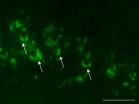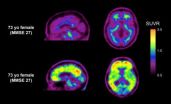(Press-News.org) PHILADELPHIA – Brain diseases associated with the misformed protein tau, including Alzheimer's disease and frontotemporal lobar degeneration with tau pathologies, are characterized by neurofibrillary tangles (NFTs) comprised of pathological tau filaments. Tau tangles are also found in progressive supranuclear palsy, cortical basal degeneration and other related tauopathies, including chronic traumatic encephalopathy due to repetitive traumatic brain injuries sustained in sports or on the battle field.
By using synthetic fibrils made from pure recombinant protein, Penn researchers provide the first direct and compelling evidence that tau fibrils alone are entirely sufficient to recruit and convert soluble tau within cells into pathological clumps in neurons, followed by transmission of tau pathology to other inter-connected brain regions from a single injection site in an animal model of tau brain disease.
The laboratory of senior author Virginia M.-Y. Lee, Ph.D., MBA, director of the Center for Neurodegenerative Disease Research and professor of Pathology and Laboratory Medicine at the Perelman School of Medicine, University of Pennsylvania, published their findings in the Journal of Neuroscience this week.
"Our new model of tau pathology spread provides an explanation to account for the stereotypical progression of Alzheimer's and other related tauopathies by implicating the cell-to-cell transmission of pathological tau in this process," says Lee.
Young mice overexpressing mutant human tau were injected with synthetic preformed tau fibrils. These fibrils were assembled from recombinant full-length tau or truncated tau containing four microtubule-binding repeats. The synthetic tau fibrils caused rapid induction of NFT-like inclusions in the brains of the mice. These inclusions then propagated from injected sites to connected brain regions in a dose- and time-dependent manner.
Interestingly, injection of the synthetic tau fibrils into either the hippocampus or the striatum and cortex led to distinctly different patterns of spreading, which is reflective of their functional connectivities. The simplest explanation for this phenomenon is that the injected pathological tau is taken up by the processes of normal neurons where it then corrupts the tau in these nerve cells followed by the transport of the corrupted tau along processes where it is released, taken up by other neurons. Then the cycle repeats itself over and over again, thereby driving disease progression, say the researchers.
What's more, unlike tau pathology that spontaneously develops in older Alzheimer's mice, the inclusions induced by the synthetic tau injections in the younger mice more closely resembled Alzheimer's tangles in their physical and biochemical make-up.
The study demonstrates that synthetic tau fibrils alone are capable of inducing authentic NFT-like tau clumps and initiating spreading of tau pathology in an Alzheimer's mouse model.
The team is now conducting studies to identify monoclonal antibodies for passive immunotherapies related to tau pathologies.
"We are also exploring the mechanisms of spreading and the relationship of tau tangles with senile plaques," says Lee. "We believe that this newly described transmission model may more faithfully recapitulate human Alzheimer's pathogenesis than the conventional transgenic mouse models of overexpressing mutant genes that develop aggregates. Exploring if this injection-transmission model is more appropriate for the progression of Alzheimer's, as well as Parkinson's, is another priority."
INFORMATION:
Co-authors are Michiyo Iba, Jing L. Guo, Jennifer D. McBride, Bin Zhang, and John Q. Trojanowski, all from Penn.
This work was supported by National Institutes of Aging (AG17586); the Marian S. Ware Alzheimer Program; the Karen Cohen Segal and Christopher S. Segal Alzheimer Drug Discovery Initiative Fund; the Paula C. Schmerler Fund for Alzheimer's Research; the Barrist Neurodegenerative Disease Research Fund; the Eleanor Margaret
Kurtz Endowed Fund; and the Mary Rasmus Endowed Fund for Alzheimer's Research.
Penn Medicine is one of the world's leading academic medical centers, dedicated to the related missions of medical education, biomedical research, and excellence in patient care. Penn Medicine consists of the Raymond and Ruth Perelman School of Medicine at the University of Pennsylvania (founded in 1765 as the nation's first medical school) and the University of Pennsylvania Health System, which together form a $4.3 billion enterprise.
The Perelman School of Medicine is currently ranked #2 in U.S. News & World Report's survey of research-oriented medical schools. The School is consistently among the nation's top recipients of funding from the National Institutes of Health, with $479.3 million awarded in the 2011 fiscal year.
The University of Pennsylvania Health System's patient care facilities include: The Hospital of the University of Pennsylvania -- recognized as one of the nation's top "Honor Roll" hospitals by U.S. News & World Report; Penn Presbyterian Medical Center; and Pennsylvania Hospital — the nation's first hospital, founded in 1751. Penn Medicine also includes additional patient care facilities and services throughout the Philadelphia region.
Penn Medicine is committed to improving lives and health through a variety of community-based programs and activities. In fiscal year 2011, Penn Medicine provided $854 million to benefit our community.
Transmission of tangles in Alzheimer's mice provides more authentic model of tau pathology
New model provides first step in generating new therapies
2013-01-16
ELSE PRESS RELEASES FROM THIS DATE:
Tracing the impact of amyloid beta in mild cognitive impairment
2013-01-16
The amount of amyloid β (Aβ) in the brains of people with mild cognitive impairment (MCI) is contributing to early memory loss, and increases with severity of symptoms, finds a study in BioMed Central's open access journal Alzheimer's Research & Therapy. The non-invasive study which used 18F-florbetaben to find Aβ plaques in brain scans to also show that in MCI the affect of Aβ on memory loss is independent of other aspects of mental decline.
Positron emission tomography (PET) has previously relied on carbon-11 labeling of Aβ, however this ...
Cutting down on sugar has a small but significant effect on body weight
2013-01-16
Research: Dietary sugars and body weight: a systematic review and meta-analyses of randomised controlled trials and cohort studies
Editorial: Science souring on sugar
Feature: Sugar and the heart: old ideas revisited
Reducing sugar intake has a small but significant effect on body weight in adults, finds a paper published on bmj.com today.
Although the effect is relatively small (an average reduction of 0.8 kg), the findings provide some support for international guidelines to cut sugar intake to less than 10% of total energy to help reduce the global obesity epidemic.
Excessive ...
Blood clots and artery blockage more likely during IVF pregnancies
2013-01-16
Research: Incidence of pulmonary and venous thromboembolism in pregnancies after in vitro fertilisation: cross sectional study
In vitro fertilization (IVF) is associated with an increased risk of pulmonary embolism (blockage of the main artery of the lung) and venous thromboembolism (blood clots) during the first trimester of pregnancy, a study published today on bmj.com suggests.
IVF has been used since 1978 for the 10% of couples worldwide affected by infertility. Approximately five million individuals have so far been born after IVF.
It is well known that the ...
Virtual heart sheds new light on heart defect
2013-01-16
A virtual heart, developed at The University of Manchester, is revealing new information about one of the world's most common heart conditions.
Researchers at the School of Physics and Astronomy used cutting edge technology to build an advanced computational model of an anatomically correct sheep's heart. It was made by taking a series of very thin slices of the heart, imaging them in 2D and then using a computer programme to render them into a 3D model.
The reconstruction includes details of the complex fibre structure of the tissue, and the segmentation of the upper ...
Device tosses out unusable PV wafers
2013-01-16
Silicon wafers destined to become photovoltaic (PV) cells can take a bruising through assembly lines, as they are oxidized, annealed, purified, diffused, etched, and layered to reach their destinies as efficient converters of the sun's rays into useful electricity.
All those refinements are too much for 5% to 10% of the costly wafers. They have micro-cracks left over from incomplete wafer preparation, which causes them to break on the conveyers or during cell fabrication.
Scientists at the U.S. Department of Energy's National Renewable Energy Laboratory (NREL) have ...
Ornamental fish industry faces increasing problems with antibiotic resistance
2013-01-16
NEWPORT, Ore. – The $15 billion ornamental fish industry faces a global problem with antibiotic resistance, a new study concludes, raising concern that treatments for fish diseases may not work when needed – and creating yet another mechanism for exposing humans to antibiotic-resistant bacteria.
The risk to humans is probably minor unless they frequently work with fish or have compromised immune systems, researchers said, although transmission of disease from tropical fish has been shown to occur. More serious is the risk to this industry, which has grown significantly ...
ACP recommends Stage 3 Meaningful Use focus on measuring improvements in health outcomes
2013-01-16
PHILADELPHIA, January 15, 2013 -- Stage 3 Meaningful Use measures need to focus more on measuring improvements in patient health outcomes rather being than a large and growing collection of functional measures, the American College of Physicians (ACP) says in a letter submitted to the Health Information Technology Policy Committee (HITPC).
While praising the HITPC and its Meaningful Use Work Group for their diligence and hard work in developing recommendations for the Meaningful Use portion of the EHR Incentive Program, ACP noted that the proposed Stage 3 measures appear ...
Global warming may have severe consequences for rare Haleakalā silverswords
2013-01-16
HONOLULU — While the iconic Haleakalā silversword plant made a strong recovery from early 20th-century threats, it has now entered a period of substantial climate-related decline. New research published this week warns that global warming may have severe consequences for the silversword in its native habitat.
Known for its striking rosette, the silversword grows for 20-90 years before the single reproductive event at the end of its life, at which time it produces a large (up to six feet tall) inflorescence with as many as 600 flower heads. The plant was in jeopardy ...
Exon skipping to restore gene expression is promising therapeutic strategy for muscular dystrophy
2013-01-16
New Rochelle, NY, January 15, 2013—A novel therapeutic approach called exon skipping involves bypassing a disease-causing mutation in a gene to restore normal gene expression and protein production. Two innovative examples of this strategy used to correct gene defects associated with muscular dystrophy are described in articles in Human Gene Therapy, a peer-reviewed journal from Mary Ann Liebert, Inc., publishers. The articles are available free on the Human Gene Therapy website.
Willem Hoogaars and a team of researchers from France, the Netherlands, Finland, and Germany ...
Western University researchers identify new genetic mutation for ALS
2013-01-16
Researchers at Western University in London, Canada, have identified a new genetic mutation for amyotrophic lateral sclerosis (ALS), opening the door to future targeted therapies. Dr. Michael Strong, a scientist with Western's Robarts Research Institute and Distinguished University Professor in Clinical Neurological Sciences at the Schulich School of Medicine & Dentistry, and colleagues found that mutations within the ARHGEF28 gene are present in ALS. When they looked across both familial and sporadic forms of the disease, they found that virtually all cases of ALS demonstrated ...
LAST 30 PRESS RELEASES:
New science reporting guide published for journalists in Bulgaria
New international study reveals major survival gaps among children with cancer
New science reporting guide published for journalists in Turkey
Scientists develop a smarter mRNA therapy that knows which cells to target
Neuroanatomy-informed brain–machine hybrid intelligence for robust acoustic target detection
Eight SwRI hydrogen projects funded by ENERGYWERX
The Lundquist Institute and its start-up company Vitalex Biosciences Announces Strategic Advancement of Second-Generation fungal Vaccine VXV-01 through Phase 1 Trials under $40 Million Competitive Con
Fine particles in pollution are associated with early signs of autoimmune disease
Review article | Towards a Global Ground-Based Earth Observatory (GGBEO): Leveraging existing systems and networks
Penn and UMich create world’s smallest programmable, autonomous robots
Cleveland researchers launch first major study to address ‘hidden performance killer’ in athletes
To connect across politics, try saying what you oppose
Modulating key interaction prevents virus from entering cells
Project explores barriers to NHS career progression facing international medical graduates
Jeonbuk National University researchers explore the impact of different seasonings on the flavor perception of Doenjang soup
Two Keck Medicine of USC Hospitals named Leapfrog Top Teaching Hospitals
World-first discovery uncovers how glioblastoma tumours dodge chemotherapy, potentially opening the door to new treatments
A fatal mix-up: How certain gut bacteria drive multiple sclerosis
New AI tool identifies not just genetic mutations, but the diseases they may cause
Deep-learning model predicts how fruit flies form, cell by cell
Combination pills for high blood pressure may simplify treatment, improve long-term health
Immune system keeps mucosal fungi in check
Neurons within the brain use simple rules to localize genetic messages
Electrodes created using light
Second-hand gift-giving is a well-deliberated decision
How human interaction drove evolution to make bears less aggressive
National Poll: Few parents offer teens guidance on healthy eating during holiday season
Cannabis derivatives could provide new ovarian cancer treatments
Raising strong yeast as a petroleum substitute
Clues to the origin of hot Jupiters hidden in their orbits
[Press-News.org] Transmission of tangles in Alzheimer's mice provides more authentic model of tau pathologyNew model provides first step in generating new therapies




